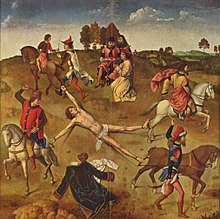
Back Vierteilen ALS تقطيع أوصال Arabic Esquarterament Catalan Poprava rozčtvrcením Czech Sønderrivning med heste Danish Vierteilung German Διαμελισμός Greek Kvaronumo Esperanto Desmembramiento Spanish مثله کردن Persian



Dismemberment is the act of completely disconnecting and or removing the limbs from a living or dead being. It has been practiced upon human beings as a form of capital punishment, especially in connection with regicide, but can occur as a result of a traumatic accident, or in connection with murder, suicide, or cannibalism. As opposed to surgical amputation of limbs, dismemberment is often fatal. In criminology, a distinction is made between offensive dismemberment, in which dismemberment is the primary objective of the dismemberer, and defensive dismemberment, in which the motivation is to destroy evidence.[1]
In 2019, American psychiatrists and medical professionals Michael H. Stone, Gary Brucato and Ann Burgess proposed formal criteria by which "dismemberment" might be systematically distinguished from the act of mutilation, as these terms are commonly used interchangeably. They suggested that dismemberment involves "the entire removal, by any means, of a large section of the body of a living or dead person, specifically, the head (also termed decapitation), arms, hands, torso, pelvic area, legs, or feet". Mutilation, by contrast, involves "the removal or irreparable disfigurement, by any means, of some smaller portion of one of those larger sections of a living or dead person. The latter would include castration (removal of the testes), disembowelment (removal of internal organs), and flaying (removal of the skin)." According to these parameters, removing a whole hand would constitute dismemberment, while removing or damaging a finger would be mutilation; decapitation of a full head would be dismemberment, while removing or damaging a part of the face would be mutilation; and removing a whole torso would be dismemberment, while removing or damaging a breast or the organs contained within the torso would be mutilation.[2]

- ^ Persaud, Raj (8 June 2012). "The Psychology of Corpse Dismemberment – The Motivation Behind the Most Grotesque of Crimes". HuffPost UK. Retrieved 27 April 2019.
- ^ Michael H. Stone & Gary Brucato. The New Evil: Understanding the Emergence of Modern Violent Crime (Amherst, New York: Prometheus Books, 2019), pp. 83–84.
© MMXXIII Rich X Search. We shall prevail. All rights reserved. Rich X Search